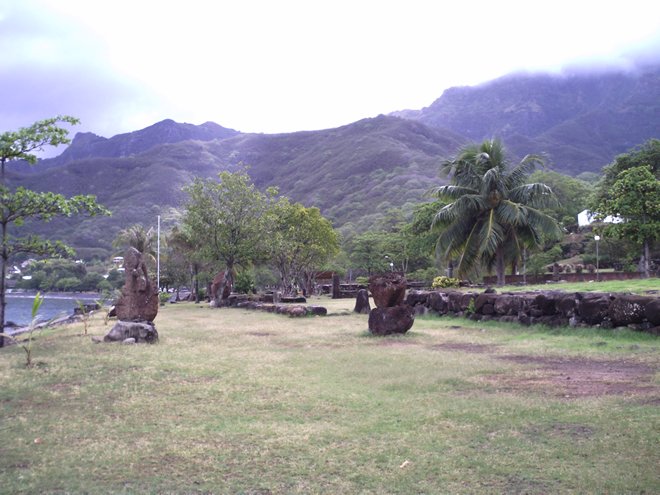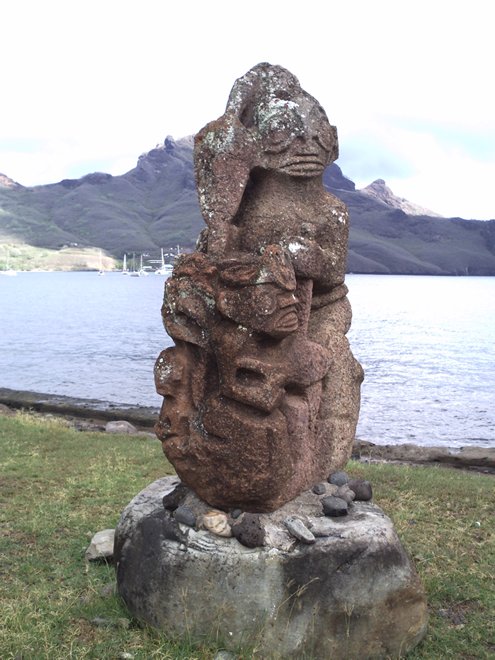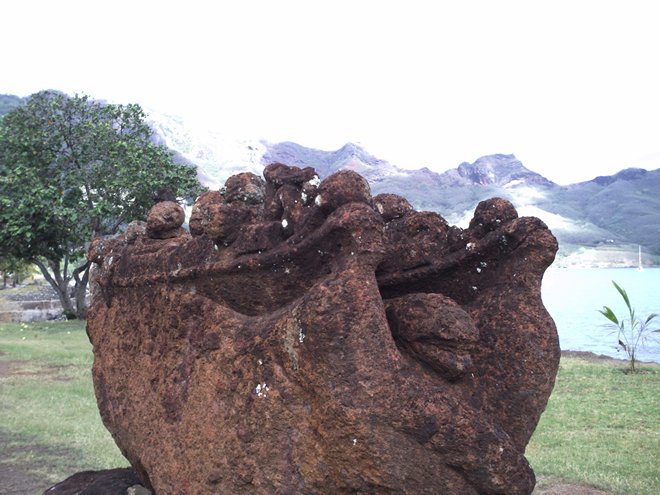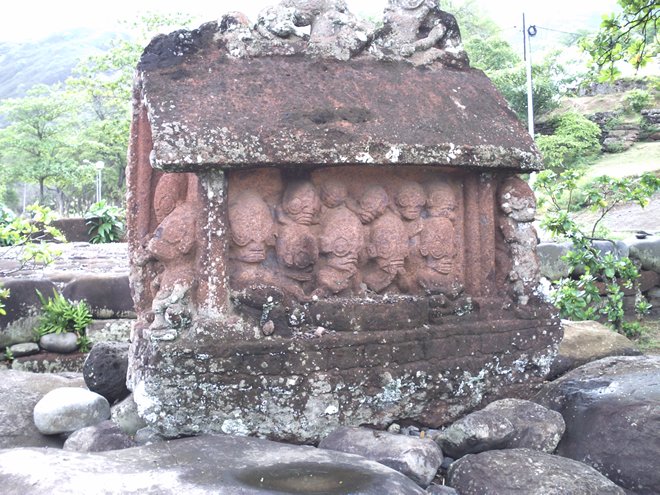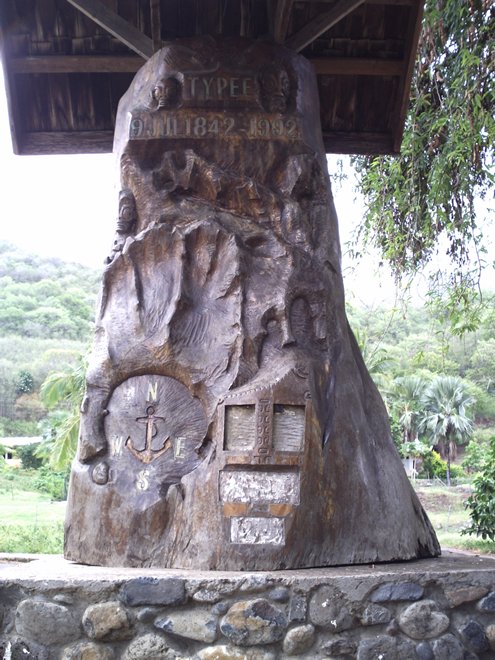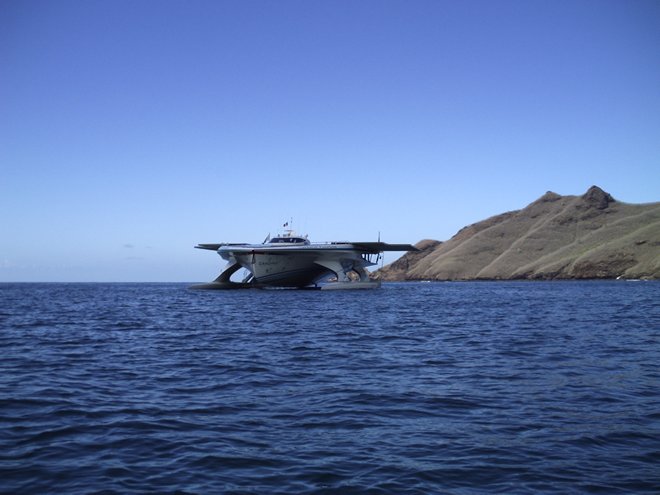Some Culture - with photos

|
At
anchor Baie de Taiohae, Nuka Hiva
Wind: Light, variable Weather: Sunny, warm. Yesterday afternoon I went for a walk and explored a nearby cultural site.
From a noticeboard describing the site: “The site used to be the home of Putahaii, Kiatonui's mother, he was the haka'iki (chief) of Taiohae at the end of the 18th century and the place is famous for holding the first exchanges between Europeans and Marquesans. Reverend Crook went to the chief's grandson to exchange names during the traditional ceremony of haaikoa. E. Roberts, an English beachcomber, who landed in 1799 exchanged names with Kiatonui who gave him his sister as a reward. In 1804, the Russian captaion Von Krusenstern met the great chief. Then Captain David Porter claimed the island for America in 1813. Kiatonui died and his grandson Temoano succeeded him; but at 13 years old he left the island to travel with missionaries back to England. When he came back in 1839, his authority was challenged by an old warrior named Pakoko. In 1842, French Admiral Dupetit-Thouars claimed the island for the king of France. He relied on Temoana to impose French authority but troubled times continued. In 1852, Commander Bolle who had fallen in love with Temoana's wife pretended he was a rebel. The hak'iki and his wife Vaekehu were sent to court in Tahiti, but French Governor Pagge did not consider the case serious and sent them back to Taiohae. On their return, they were converted to Catholocism and the site was rebuilt. In 1863, enslaved Marquesan workers were brought back from Peru. Carrying smallpox their return caused a terrible epidemic and Temoana died from pleurisy about the same time. Twenty-eight years later in 1901, Vaekehu passed away and the site was definitely abandoned. It was restored for the second Marquesan Art Festival.”
I found this last carving interesting. Apart from the usual stylised large heads and eyes, two of the figures have their hands in their mouths as if they are anxious or frightened of something. I wonder when this particular carving dates from? I do not recall seeing many of the stone carvings showing such exressions. Hmm. A little further on from this cultural site I found a more recent but also very ineteresting carving, this one in wood:
Unfortunately it has been slightly defaced but if you look at the top of the carving you will see inscribed, “TYPEE: 9 Jul 1842 – 1992.” Now for all you literary types out there I no doubt do not need to remind you that “Typee” was Herman Melville's first novel which was set in the Marquesas based on his experience when he deserted the whaling ship he was on. This caused me to do a little more research. It turns out that Melville's short experience in the Marquesas was here in Nuku Hiva and actually just around the corner at Taipivai, the bay I have just come from, and the beautiful valley which I briefly tried to describe. I remember reading Typee many years ago now, as I recall quite a fast moving (for me) and interesting novel. The message I got out of it was the illusory nature of things, how the apparently idyllic existence the natives lived was not so perfect, and how the narrator after a short while yearned for his own civilisation and had to escape. I recall Melville questioning the foundations of the houses, made of stone, which he suspected pre-dated the existing civilisation, thus perhaps a metaphor questioning the foundations of the whole civilisation. Such is the fun of analysing works of art. Currently I am reading a non fiction book, “The Parable of the Tribes: The Problem of Power in Social Evolution”, by Andrew Bard Schmookler. Perhaps a little dated and I think Schmlooker's analogy between biological evolution and social evolution a little strained at times but nonetheless interesting ideas. I think the notion which he is attacking, that we in any way have chosen the civilisation we currently live in, is something I have not believed since I do not remember so he is definitely preaching to the converted, but then perhaps the ideas from his book have influenced me through other round about ways. And I have a few problems with the way he uses the word 'power', like it was an entity I could go and talk to and say, ' Now look here, all this nonsense has just got to stop!” I am sure we are going to end up at the same conclusion, we shall see. However I am less than optimistic that we (just who are the 'we' doing the choosing?) can choose anything in the big picture. All 'we' can do is to try to understand the big picture we live in as best we can then choose the way we live our own short and largely insignificant lives according to our best lights. Our choices are strictly limited, and the consequences, well I love Shakespeare's comment on this from Hamlet (forgive me if I have quoted this before): “Our wills and fate do so contrary
run That from the play within a play, spoken by the player king, lines written by Hamlet, written by Shakespeare, to catch out the king in the actual play, Claudius. You've got to love Shakespeare. I liked what Schmookler had to say, comparing the truth of science with mythopoetic truth. He referred to Newton's comment, “If I have seen a little further it is by standing on the shoulders of Giants.” His point being that while the rational truth of scientists maybe able to be built upon the foundations of what has gone before, other kinds of truths are not open to such methods. As he puts it, Einstein could stand on Newton's shoulders but who can stand on Shakespeare's shoulders? I remember a conversation from a few years back where I was trying to make a similar point about the limitations of reason to some very rational minds. I am afraid I only alienated myself: “Robert, what the hell are you talking about?” Oh well. Now “The Tempest” is quite an amazing play, admittedly I had to read a little criticism to find the key to unlock a lot of its meaning, and shows so clearly Shakespeare's awareness of the power he had as a playwright to mess around with meaning, but nonetheless very pertinent to the clash of cultures during the age of discovery. So minds were very conscious of some of the moral dilemmas that were going on at the time. La Casa springs to mind and I recall from Alan Moorehead's book, “The Fatal Impact: An Account of the Invasion of the Pacific, 1767-1840.” I read here that James Cook realised in his second visit to Tahiti that in his first trip with the introduction of iron he had already planted the seeds of destruction for the island's culture. Great book. I remember an image of a painting by Gauguin in it of a sad Polynesian lady, reclining naked, a black bird behind her, and “Nevermore” is inscribed somewhere in the painting. Of course the allusion to Poe's, “The Raven” is obvious even to me, (not mentioned by Moorehead that I recall), again this sense of mythopoetic truths available only through non-rational modes of _expression_. The fact that Poe chose a raven as his central symbol because it is “a non-reasoning” creature capable of speech makes my little discussion a rather neat kind of nested logic. (The fact that ravens on the other hand are highly intelligent and quite capable of reason is beside the point and maybe I will keep as the subject of another little discussion.) But enough fun for me for one day. The supply ship came in yesterday so with luck amongst its cargo lay two precious jars of vegemite:
And our solar powered visitor has departed:
All
is well.
|
